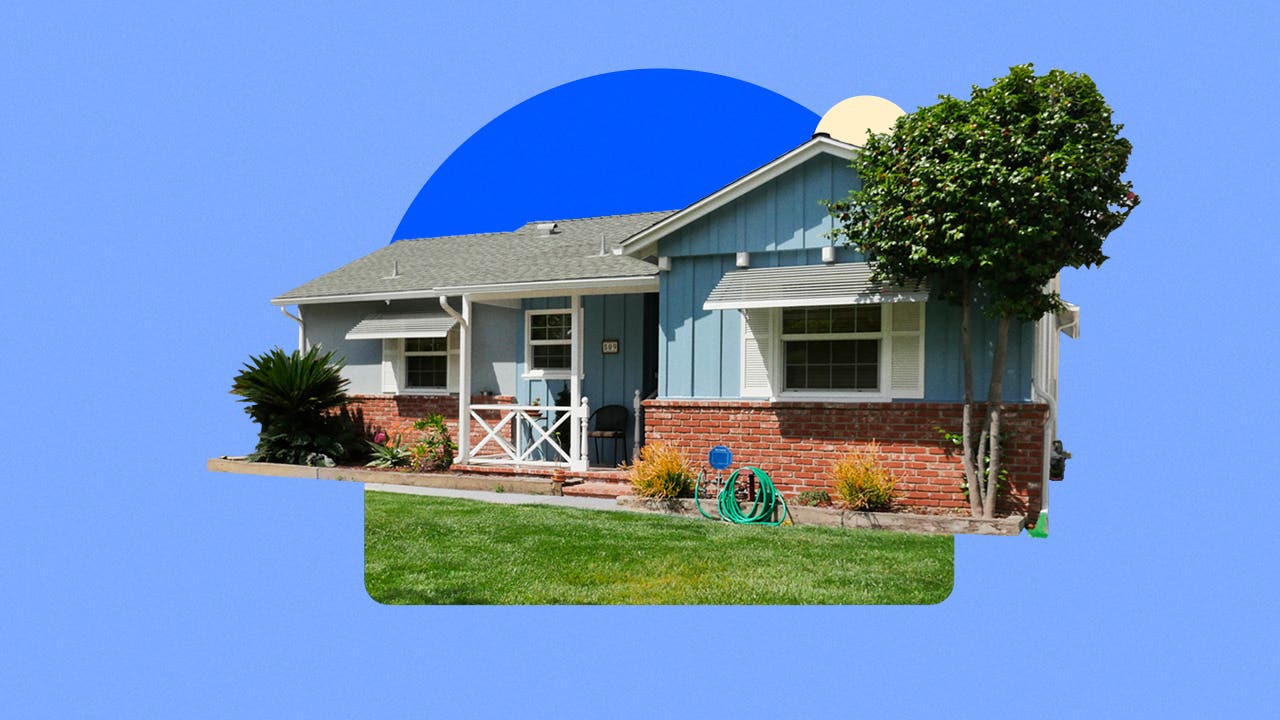FHA cash-out refinance guide

The Bankrate promise
At Bankrate we strive to help you make smarter financial decisions. While we adhere to strict , this post may contain references to products from our partners. Here's an explanation for .
Key takeaways
- An FHA cash-out refinance lets you borrow against the equity in your home without having to take out a second mortgage.
- An FHA cash-out refinance involves swapping out your current home loan with a new, larger one.
- If a FHA cash-out refinance isn’t ideal for your financial situation, a home equity loan, HELOC or personal loan could be a viable alternative.
Your home is your most valuable asset, and if you’ve paid off a significant chunk of your mortgage, it can also help you borrow more money for major expenses, such as paying for college or renovating your kitchen. One way to leverage the equity in your home is with an FHA cash-out refinance.
What is an FHA cash-out refinance?
An FHA cash-out refinance involves paying off your existing mortgage with a new, bigger mortgage insured by the Federal Housing Administration (FHA). The amount of the bigger loan is based on your equity level, what you still owe on your current loan and how much in extra funds you need. Ideally, the new mortgage would also come with a lower interest rate.
How an FHA cash-out refinance works
There’s one key piece of information that guides how much money you can get from an FHA cash-out refinance: how much your home is worth.
Let’s say you currently owe $200,000 on your existing mortgage, and an appraisal values your at $400,000.
With an FHA cash-out refinance, you’d be able to borrow up to $320,000 — which is 80 percent of your property’s value. In this case, $200,000 of that would go toward paying off your existing mortgage.
However, you don’t have to borrow the full $320,000 when obtaining an FHA cash-out refinance. Let’s say you just need $100,000 to finish a major home renovation. You’d go through a new mortgage application — similar to the process for your first mortgage — for a $300,000 mortgage instead. Once approved, $200,000 of that will be used to pay off your old mortgage, and you’ll begin making monthly payments on your new $300,000 loan.
There are also closing costs to consider, which average about 4 percent of the loan’s principal. You would need to factor those in if you’re planning to roll those expenses into the new mortgage, as well. You might also need to establish a new escrow account as part of your FHA cash-out plan.
FHA cash-out refinance requirements
The FHA has minimum requirements for FHA loans, including refinances, but FHA lenders can also set their own standards.
- Credit score: While FHA loans often make headlines for allowing credit scores as low as 500, the reality is you’ll need a higher credit score to obtain the best deal on an FHA cash-out refinance. Some lenders will approve a credit score as low as 620, but the lowest rates will go to borrowers with credit scores of 740 or higher. If you’re hoping to do a cash-out refinance, work to improve your credit well before applying.
- Debt-to-income (DTI) ratio: In most cases, your DTI ratio can’t exceed 43 percent. If you have other loans or debt, it’s wise to try to pay things down before you apply for a refinance.
- Loan-to-value (LTV) ratio: You’ll need at least 20 percent equity in your property after the cash-out refinance.
- Loan limits: There’s a cap on how much you can borrow, regardless of how much your property is now worth. In most places, the limit for 2024 is $498,257 for a single-family home, but some higher-priced areas have a limit of $1,149,835.
- Mortgage insurance: All FHA loans, including cash-out refinances, require mortgage insurance. You’ll pay an upfront premium of 1.75 percent of the loan amount, then an annual premium that ranges between 0.45 percent and 0.80 percent of the loan amount, depending on the length of your new mortgage. (While most FHA loans require mortgage insurance for the entire loan term, you can do away with it after 11 years if you make a down payment of at least 10 percent.)
- Occupancy and property requirements: The home must be your primary residence, and you’ll need to have lived in the property for at least the last 12 months. If you just moved in six months ago, you’ll need to hang tight before thinking about a cash-out refinance.
- Payment standing: You’ll need to be in good standing with your current mortgage, which means you’ve made at least the past 12 monthly payments on time.
How much does an FHA cash-out refinance cost?
An FHA cash-out refinance isn’t a free road to more money. You’ll need to pay closing costs on the new loan, which typically range between 2 percent and 6 percent of the loan amount. So, if you’re taking out $250,000, those closing costs might be as low as $5,000 or as high as $15,000.
Your closing costs will include an upfront FHA mortgage insurance premium (MIP) of 1.75 percent of the loan amount (in the above example, that’s $4,375). There are plenty of other fees to consider, too, including charges from your lender and for services like an appraisal and title search.
Pros and cons of an FHA cash-out refinance
FHA cash-out refinance loans come with benefits that can make them an attractive option for homeowners looking to pull equity from their homes. Still, it’s important to consider the drawbacks before shopping around with lenders and formally applying for a loan.
Pros of an FHA cash-out refinance
- Flexible eligibility guidelines. You don’t need perfect credit to qualify for a loan. That said, a lower score means you’ll likely get a higher rate.
- FHA loan not required. These mortgage products are open to borrowers with any kind of existing mortgage — not just FHA loans.
- Assumable by other buyers. When you’re ready to move, another buyer who meets FHA credit qualifying guidelines could take over the loan. “If interest rates are much higher than they are today, the listing can market an assumable loan and potentially be easier to sell,” says Todd Johnson, senior vice president and capital markets portfolio management director for Wells Fargo.
Cons of an FHA cash-out refinance
- Increased debt load. A higher mortgage balance means you’ll likely have bigger monthly mortgage payments.
- Borrowing costs. You’ll need to pay for other costs like MIP, an appraisal fee and title services when taking out an FHA cash-out refinance.
- Limited to primary residences. FHA cash-out refinances are only allowed on the home you live in — you couldn’t do this refinance on a rental or second home.
FHA cash-out refinance vs. other loan types
With their flexible eligibility guidelines an FHA cash-out refinance can be a good choice for some homeowners, they are certainly not the only option. Depending on your needs and financial picture, it may be worth considering a conventional cash-out refinance or a FHA streamline refinance.
FHA cash-out vs. conventional cash-out refinance
Both an FHA cash-out refinance and a conventional cash-out refinance have the same endpoint: getting more money. However, if you have the credit needed for the conventional route, you could opt for that to avoid paying MIP.
This is a key consideration, says Johnson. Conventional mortgages with an 80 percent LTV ratio won’t require private mortgage insurance (different from FHA MIP). This doesn’t necessarily make a conventional loan cheaper, though. “It’s important for the customer to always approach these conversations with lenders to make an informed choice that will make the best decision for their personal circumstances,” says Johnson. It’s also worth a conversation with your accountant or financial advisor, who can help you understand whether refinancing will impact your ability to save.
FHA cash-out vs. FHA streamline refinance
If you don’t need the additional cash, an FHA streamline refinance can be an easier route to try to save money on your monthly payments. As the name implies, the process is streamlined — less paperwork and less underwriting work needed. There are non-credit qualifying options, too, meaning you could get approved without any research on your credit score. However, FHA streamline refinances are only available to existing FHA borrowers.
FHA cash-out refinance |
FHA streamline refinance |
|
|---|---|---|
| Credit score required | Generally 620 (some lenders might accept lower) | No credit documentation needed |
| Ability to take out more money | Yes | No |
| Appraisal | Yes | No |
| Available to borrowers with | Any kind of existing mortgage (conventional, FHA, VA or USDA) | Must have an existing FHA mortgage |
FHA cash-out refinance FAQ
-
As you compare FHA cash-out refinance rates, pay attention to the annual percentage rate, or APR, which accounts for the fees you’ll pay. The APR offers a more accurate picture of the loan’s cost. For example, you might see an interest rate of 7.76 percent for a 30-year FHA refinance. The APR, though, might be more than 8.69 percent due to the inclusion of mortgage insurance, discount points and other costs.
-
It takes an average of 45 days to close on an FHA loan refinance as of April 2024, according to ICE Mortgage Technology. However, many factors can impact the timeline, including having all your documents ready and how long it takes to get an appraisal.
-
One of the best parts about an FHA cash-out is that there are no restrictions on how you use the funds. For example, you can put the funds toward larger expenses, like higher education or paying off credit card debt.
-
Yes, you can do an FHA cash-out refinance if your current mortgage is not an FHA loan. You can apply for an FHA cash-out refinance even if you currently have a conventional loan or a government-backed loan, like a VA loan.
-
There are some alternatives to an FHA cash-out refinance that don’t involve refinancing your home. One option is a home equity loan, which is a second mortgage. You borrow a lump sum, based on the size of your ownership stake, at a fixed interest rate, and you’ll pay the money back in installments over a set period. Another option is a home equity line of credit (HELOC), where you’ll borrow funds as needed through a line of credit. There is also the option of a personal loan, which gets you money quickly (some lenders will get you cash the next business day) and has lower credit score requirements for approval. There’s a catch, though: Many personal loans come with excessively high interest rates.
Related Articles



